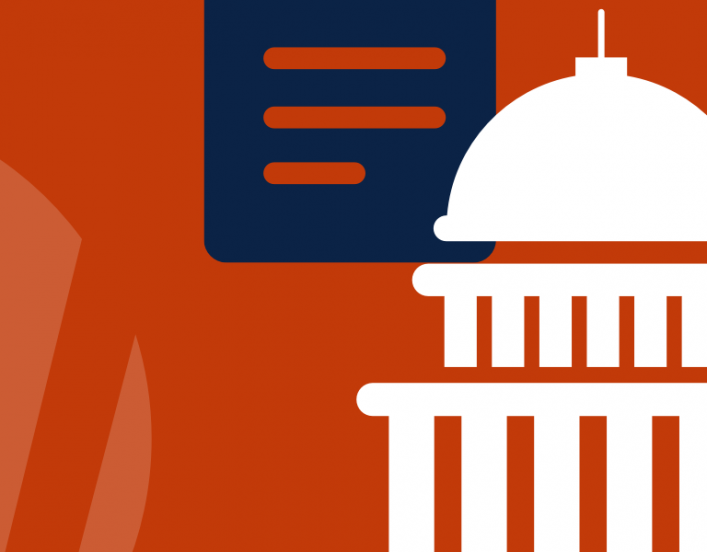Where We Stand: Sexual Harassment and Sexual Violence in School
AAUW advocates equitable access to education and climates free of harassment, bullying, and sexual assault.
Sexual harassment and violence in schools create hostile environments and can negatively impact students’ learning, mental health, and wellbeing. Sexual harassment is unwelcome conduct of a sexual nature and can be verbal, nonverbal, or physical—including sexual assault. Though sexual harassment and violence in schools are unlawful as a form of sex discrimination under Title IX of the Education Amendments of 1972, AAUW’s own research revealed that harassment in schools starts early and affects most students. AAUW is committed to protecting the right of all students to be free from sexual harassment and violence.
AAUW In Action
All public policy actions take direction from the AAUW Public Policy Priorities, voted on by members every two years. AAUW is a nonpartisan organization—but nonpartisan does not mean “non-political”. Since its first meeting in 1881, AAUW has been a catalyst for change. Together, through our coordinated and strategic advocacy, we’ve enacted invaluable legislation at the federal, state, and local levels. The 2021-2023 Public Policy priorities directly identify advocating for school climates free of harassment, bullying, and sexual assault.
The public policy team engages in many efforts on this key issue, including but not limited to:
- Working in coalition with other gender equity and civil rights organizations, including the Education Task Force of the Leadership Conference on Civil and Human Rights and the National Coalition for Women and Girls in Education.
- Mobilizing AAUW advocates and members through targeted calls to action on important legislation, like the Gender Equity in Education Act (GEEA).
- Engaging directly with elected leaders and the public through calls, letters to political offices, and comments and testimonies in hearings.
- Providing voter education resources on key equity issues to consider during elections and offering information on how elected officials have voted in the past (more about this and Get Out the Vote guides at the AAUW Action Fund).
Primary and Secondary Education
Unfortunately, sexual harassment and violence continue to be prevalent in elementary, middle, and high schools across the United States. According to AAUW’s own research, nearly half of students in grades 7-12 experience sexual harassment. In the 2017-18 school year alone, the U.S. Government Accountability Office (GAO) reported over 1,000 cases of rape and 7,000 cases of sexual assault other than rape in K-12 public schools—though these incidents remain generally underreported.
The GAO found that K-12 students who experience hostile behaviors, including sexual harassment and assault, are more likely to experience depression and anxiety as well as decreased participation and achievement in school. While boys and girls are both negatively affected by sexual harassment, girls are more likely than boys to say sexual harassment caused them to have trouble sleeping, not want to go to school, or change the way they went to or home from school.
Higher Education
Sexual harassment and assault are also shockingly prevalent on college and university campuses. AAUW’s own research revealed that two-thirds of college students experience sexual harassment. Studies have also found that approximately 26% of all female undergraduate students and 6.8% of all male undergraduate students have experienced sexual assault. Though both men and women are targets of violence on campus, sexual assault disproportionately affects college women and impedes survivors’ ability to participate fully in their education. Educational equity for women and girls requires fair, responsive, fully-developed campus sexual assault policies; knowledgeable administrators; and ultimately an end to sexual violence on campuses.
Title IX
Title IX of the Education Amendments of 1972 is the federal law that prohibits sex discrimination, including sexual harassment and violence, in education. Title IX requires schools that receive federal funding to evaluate their current practices, adopt and publish a policy against sex discrimination, and implement grievance procedures providing for prompt and equitable resolution of student and employee discrimination complaints. Title IX protects all students from unlawful sexual harassment and violence in all of a school’s programs or activities, whether they take place in school facilities or elsewhere.
In 2017, however, the U.S. Department of Education rescinded multiple importance guidance documents that had clarified what Title IX requires schools to do to prevent and address sexual harassment and violence. Then, in 2020, the Department of Education released a new rule which narrowed the definition of sexual harassment, altered when schools must respond to reports of sexual harassment and violence, and put in place processes that make it harder for students to come forward about sexual harassment or assault.
Proposed changes to current Title IX regulations are not expected until May 2022, leaving students and survivors of sexual harassment and violence without the resources and support they need now. AAUW supports efforts asking the Department of Education to take urgent action on proposed Title IX changes to protect students’ civil rights.
The Clery Act
The Jeanne Clery Disclosure of Campus Security Policy and Campus Crime Statistics Act (Clery Act) requires colleges and universities who participate in federal financial aid programs to disclose campus crime statistics and security information, which each school provides publicly. The Clery Act further requires colleges and universities to have disciplinary policies for incidents of sexual assault, domestic and dating violence, and stalking and prohibits retaliation against any student or employee who files a complaint.
In 2013, Congress reauthorized the Violence Against Women Act and included provisions to improve campus safety. Schools are now required to report additional crime statistics on domestic violence, dating violence, and stalking; update procedures following an incident of sexual violence; and provide prevention and bystander intervention training to all students and employees. In addition to the long-standing obligations that schools have under Title IX, these laws can work together to ensure that students have the information they need regarding campus safety, as well as a clear course of action when sexual harassment or violence occurs.
The Civil Rights Data Collection
Since 1968, the Department of Education has administered the Civil Rights Data Collection (CRDC), which collects data on key education and civil rights issues in our nation’s public schools. In the past several years, the CRDC has been improved to shed additional light on the pervasiveness of sex discrimination, including sexual harassment and violence, in our schools. The CRDC now includes several important, school-specific gender equity points that are helpful to advocates, parents, students, educators, and Title IX coordinators at schools nationwide. The Department of Education should maintain the CRDC going forward.
Ending Sexual Harassment and Violence in Schools
The data collected through the Clery Act and CRDC are critical to informing effective responses and prevention efforts to eliminate sexual harassment and violence in schools. The bipartisan Hold Accountable and Lend Transparency (HALT) on Campus Sexual Violence Act, reintroduced in the House of Representatives in July 2021, would further increase transparency in reporting on campus sexual violence and strengthen prevention and enforcement efforts. Climate and victimization surveys can also help schools better understand both reported and unreported incidents of sexual harassment and violence, as well as contributing cultural issues on their campuses.
AAUW supports federal legislation that strengthens students’ civil rights protections and Title IX enforcement, including comprehensive training and support for Title IX coordinators. The Gender Equity in Education Act (GEEA) would provide educational entities and Title IX coordinators the resources, training, and technical assistance necessary to ensure equity in education and would establish an Office of Gender Equity in the Department of Education to coordinate interagency enforcement of Title IX. GEEA would also authorize competitive grants to K-12 schools, colleges, local educational agencies, or states to support their gender equity work.
Related
Crossing the Line: Sexual Harassment at School (2011)

Policy Recommendations: Campus Sexual Misconduct

